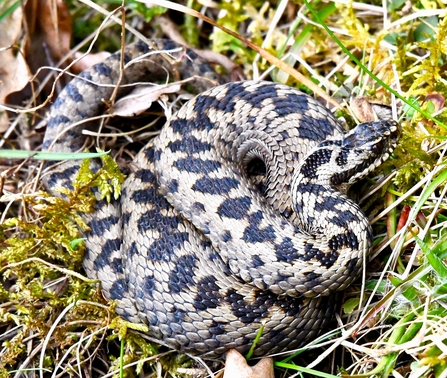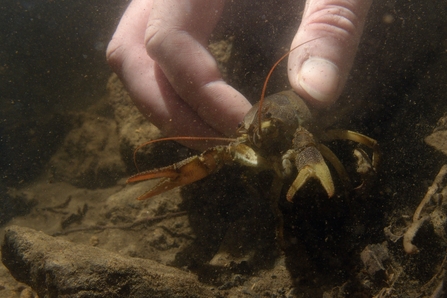Gloucestershire Wildlife Trust have announced their success in securing funding from Natural England’s Species Recovery Programme, to support the recovery of adders and native crayfish across the county. The programme is designed to support targeted action for England’s priority and threatened species, helping to improve their conservation status. Two GWT projects have received funding: Recovering Adders on the Cotswold Escarpment and the River Frome Native Crayfish Recovery Project.
Thousands of pounds awarded to support endangered species in Gloucestershire
© Chris Lawrence

An adder © Hugh Gregory
The Recovering Adders project will focus on enhancing habitat for these enigmatic reptiles who call the grasslands and woodlands of the Cotswolds home. The UK’s only venomous snake, the adder is an often misunderstood but wonderful species that have sadly been in huge decline across the country and now have protected status.
Grove Sykes, Lead Land Manager East at GWT, has said that,
“The project is focused around enhancing and connecting important areas for these secretive and stunning reptiles. The Cotswold Escarpment hosts an important population of adders, but sadly they’re facing lots of challenges. With help from this project, we’ll be working with other landowners to plant hedgerows, manage scrub, create hibernaculars [places for adders to live] and creating connections between suitable habitat, to encourage populations to move around, grow and ultimately strengthen and become more resilient.”

A native crayfish being released into a stream during a previous translocation here in Gloucestershire © Nick Upton
Away from the grasslands and woodlands of the Cotswold Escarpment, the River Frome Native Crayfish Recovery Project will focus on improving the long-term survival chances of the elusive white-clawed crayfish within the River Frome catchment in Gloucestershire. Once widespread, this species has now been tragically decimated and is limited to four small areas of the river. The threat of crayfish plague, brought into our waterways by the introduction of non-native North American signal crayfish, means urgent action is required to increase the resilience of these last remaining populations and prevent their extinction here in Gloucestershire.
Richard Spyvee, GWT’s Lead on Wilder Landscapes, commented that,
“We’ll be using a range of techniques to combat the threats to our native crayfish, including conservation translocations where we move small numbers of existing crayfish and natural flood management, such as installing leaky dams, to restore these important ecosystem engineers. It’s all about improving the range and resilience of the species, making the existing populations viable again and combatting the threat of extinction.”
A leaky dam, one of the habitat improvements that will be carried out by GWT © Nick Upton
Focusing on individual species at a time when the climate and nature crises are looming large might seem like an unusual approach but Ian Stevenson, GWT’s Head of Nature Recovery Zones, explains how the projects will have a significant impact beyond just adders and crayfish:
“Natural England’s Species Recovery Programme is enabling us to not only recover high-priority species, it’s allowing us to do this at a landscape scale in the Cotswolds. We’re not just focusing on individual populations, but how these populations can be extended and enhanced across the landscape. This is great for adders and white-clawed crayfish, but also for a wealth of other species who will benefit from this vital work. It all adds up, with more and more species able to thrive and with essential ecosystems slowly being restored, all vital to tackling the climate and ecological crises in our wonderful county.”
Find out more about Gloucestershire Wildlife Trust’s approach to landscape-scale nature restoration here.
